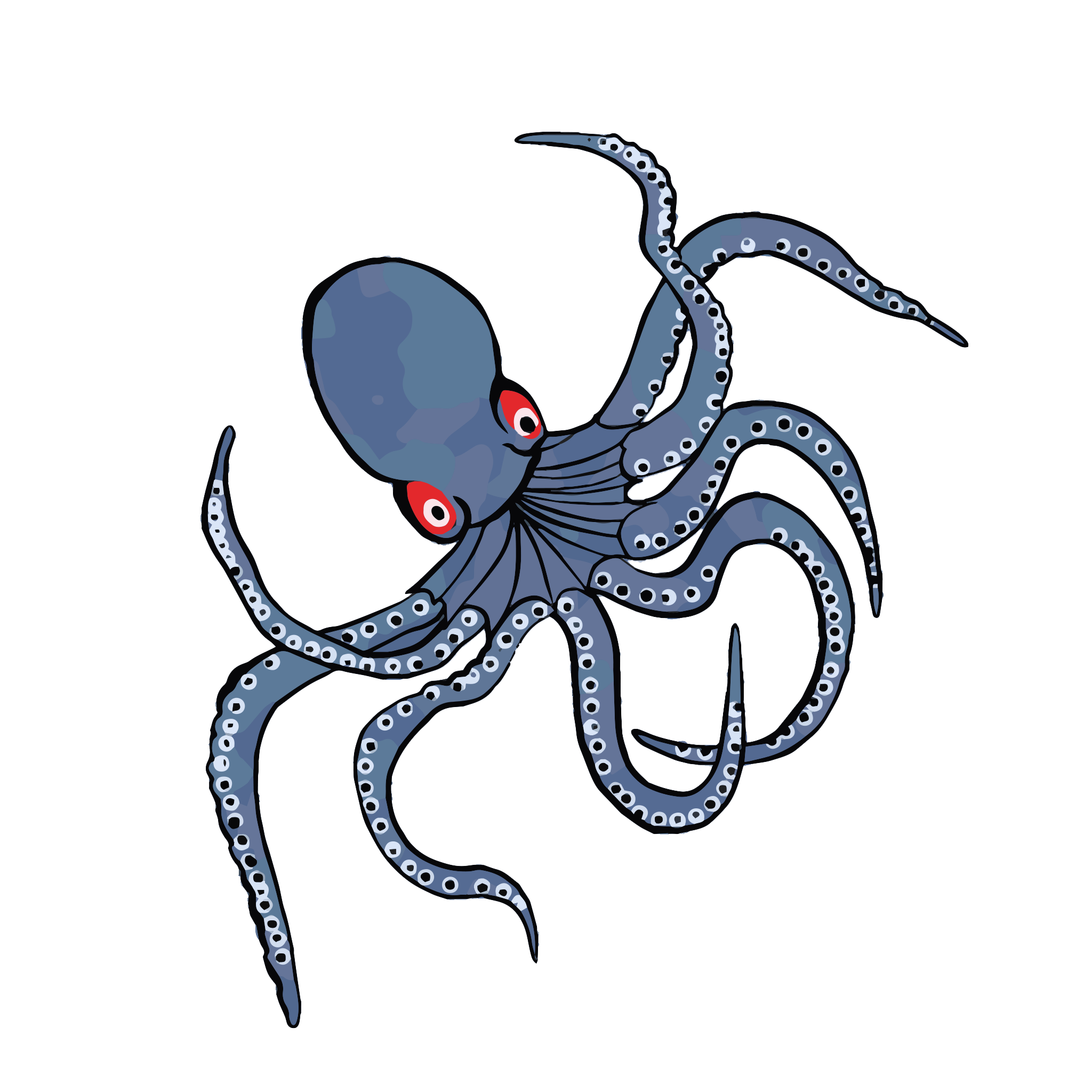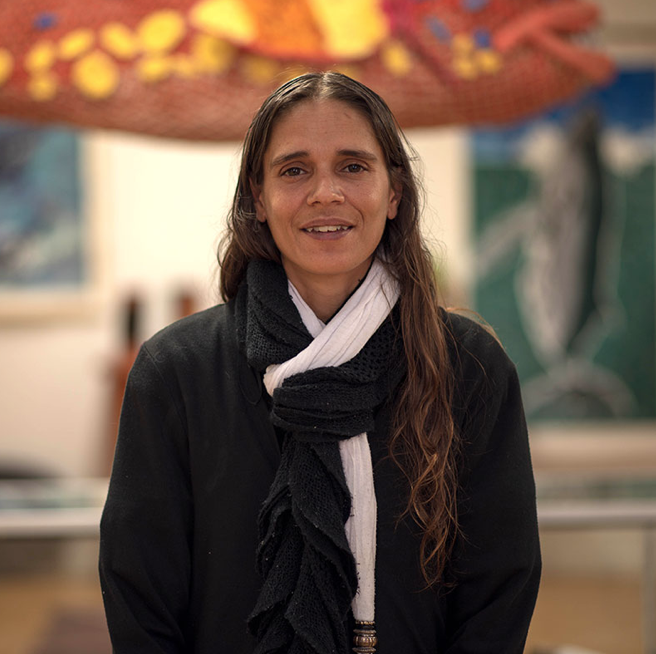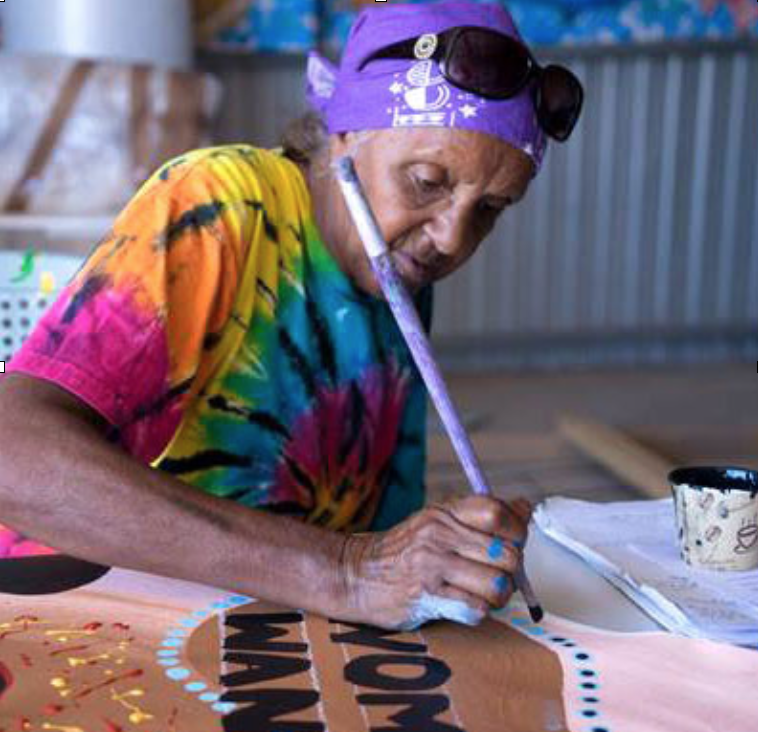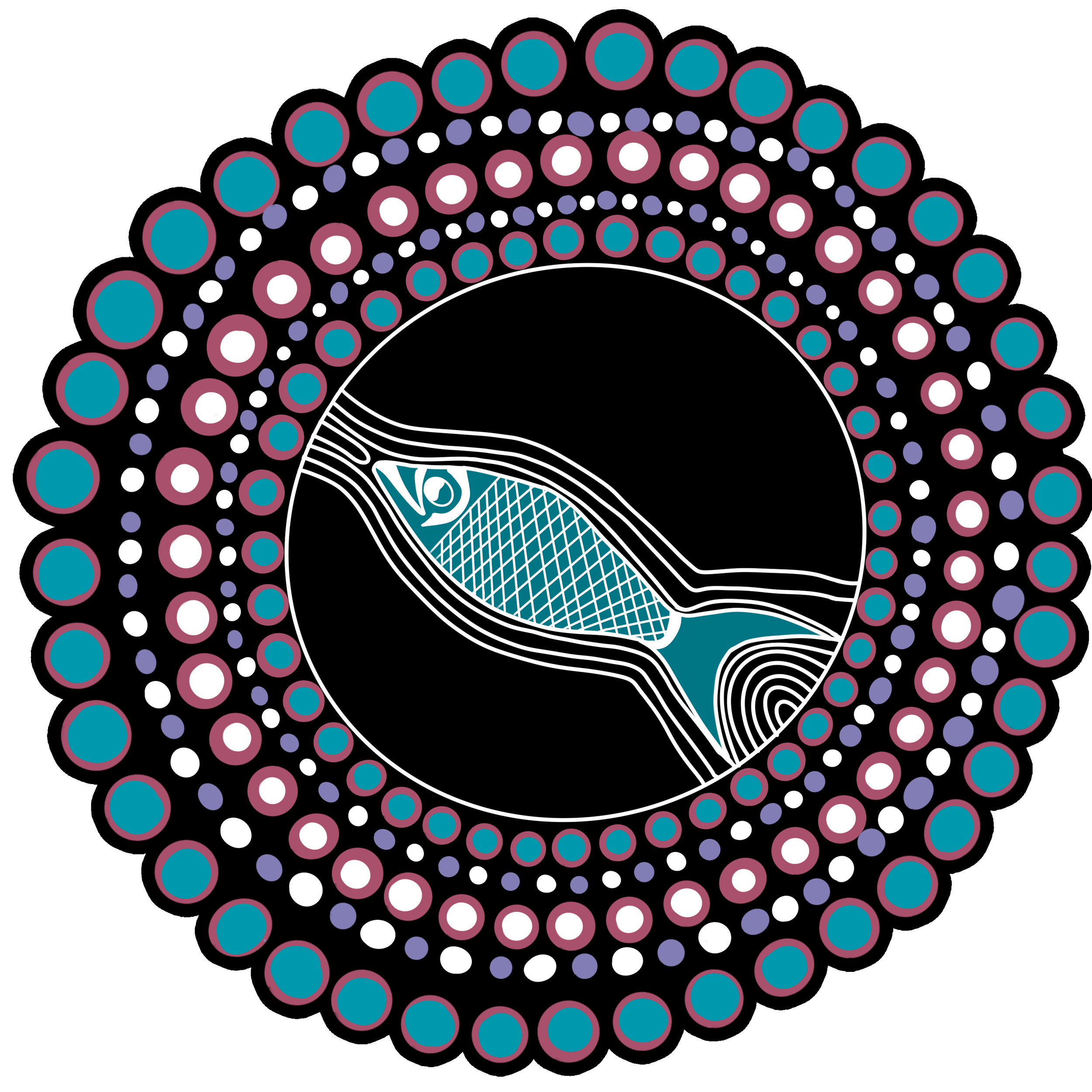
About the Artists
The story of the painting…
Australian Women in Fishing Art Work*
After my mum’s passing, I found myself on a path that seemed to guide me to Ceduna. It became a place of deep acceptance, not only for my mum but for me as well. It was the emotional pull of this sacred place, that I felt. In my heart, I knew I needed to reach out to Aunty Jo—a woman of profound wisdom and creativity had told me years earlier that when the time was right she would sit and paint my song line and the time was now … When I asked her to help me paint my story, what started as a personal healing process grew into something far greater: a shared painting of healing.
Together with Aunty Jo, Aunty Jenny, Aunty Verna and Collete Gray with added beauty from Aunty Christine and Sherrie Jones (Shorty) this group of extraordinary women, we embarked on this artistic journey. We had no solid plan, no predetermined image of what the final painting would be. But that was the beauty of it—each stroke, each symbol, and each color evolved naturally, carrying meanings significant to one or all of us.
At the centre of the universe we painted, my mum’s resting place. Around this central point, the painting bloomed, drawing inspiration from the natural elements, the ocean, and the deep connection between us all from the whale that passed her window to the prawn with two meanings one for mum the prawning lady and one for me
Through this process, I had the immense pleasure of not only contributing to the artwork but also learning so much from the amazing women around me. Every detail, from the creatures to the cosmic elements, represents a journey of healing, strength, and unity. It’s more than a painting—it’s a symbol of where we’ve been, where we are, and how, through each other and through art, we continue to heal and grow.
This painting now stands as a testament to the power of storytelling, connection, and shared creativity. It is a reminder that, even in our most painful moments, we can find beauty and meaning by coming together and honoring the journeys that brought us through.
*Artwork still in progress.
*Artwork still in progress.
About the Artists + Bio
Collette Gray
Collette Gray was born in Ceduna, South Australia, in 1984. She has been closely affiliated with Arts Ceduna since 2014, where she currently works as a Senior Arts Worker. Colette’s key techniques with art include dot painting and free-hand painting, using small skewer sticks and a mixture of paint brushes. Her key medium is working with acrylic paint on canvas, but she engages regularly in experimental approaches to medium selection, which may include wooden boards, corrugated and metal panels, and exterior paints. She also painted larger murals, but she is known for her contemporary Indigenous artworks and experimental art. Collette learned entry-level art during her high school based in Ceduna.
She is highly inspired by both her mother Janine Gray and her in-laws, the Lawrie-Lennon family. Collette also looks up to Pam Diment, a previous arts coordinator and potter by trade, who has been Colette’s mentor for more than 40 years. Collette’s key accomplishments is to engage in thrifty and sustainable practices. She regularly reworks, changes and completes artworks that other artists have begun that have been abandoned or forgotten, sitting in the art studio for a long time. She repurposes and transforms these works into unique works for sale in the gallery. Another of her achievements, which she prides herself in, is her long-term commitment to working for serving the arts community at Arts Ceduna since 2014.
Collette continues to draw inspiration from the surrounding environment of the Westcoast of South Australia where she lives and grew up. She also keeps the knowledge strong from her Gugada/Kokatha Elders, passed on to her, and she is proudly continuing to teach the younger generation of artists in Ceduna, but also her own children. Collette is inspired by, and often paints the unique place titled ‘Ceduna Waters’, which is located east of Ceduna when heading towards Shelley beach.
Janine Gray (Aunty Jenny)
Janine Gray was born in Koonibba, South Australia in 1954. Growing up in this Aboriginal Community, roughly 30 kilometres heading west from Ceduna, Janine has been living in Ceduna since 2017. Previously she also lived in the Scotdesco Aboriginal Community where her partner is from. Janine produces paintings, murals, pottery, and lino-printing. Her main medium is acrylic on canvas, but she also paints on different surfaces and mediums such as metal and wooden panels, textiles and clay. Janine’s techniques, seen throughout all her artworks are both dots and fine lines. Art mentors who inspired Janine were for example her art teacher during her schooling, but also her Gugada/Kokatha Elders.
Janine has accomplished tremendous artistic achievements throughout her art career. She entered many exhibitions and art prizes, for example, the ‘Our Mob’ in Adelaide, ‘Malka ArtPrize’ in Port Augusta, Port Lincoln Art Prize and Red Poles exhibitions. Janine also accomplished an art residency at Penong school where she shared and taught her art to children. Janine enjoys spending time outdoors where she will be found fishing in her favourite spots on the coastlines of Ceduna. Janine is inspired by her environment and knowledge of her Culture, with the Australian ocean and wildlife also recurring as dominant themes in her work.
Josephine Lennon
Josephine Lennon was born in 1972 in Port Augusta, a city 500 kilometers West of Adelaide, South Australia. Currently living in Ceduna South Australia, Josephine participates in the local Community Development Programme’s Creative Arts Program. Based at Arts Ceduna, situated in the Ceduna Aboriginal Arts and Cultural Centre, Josephine also practices painting from home, working actively as a consignment artist. Her unique style and use of methods include the careful application of fine lines and dots that is represented in Aboriginal art.
Working with mainly acrylic paints and on pre-primed canvas, Josephine also enjoys applying acrylics on different materials, such as wooden boards, but another interest is painting ceramics. Josephine is an acclaimed and award-winning artist, producing artworks that address themes of Country and the unique environments, vegetation, and animals that inspire her, such as Sturt Desert Peas, Paper Daisies, bush tucker, whales, fire, wind, and the salt lakes. Josephine learned arts practice during school, but her older sister, mother, and grandmother remain her biggest inspiration. Josephine also appreciates the influence of another mentor, Pam Diment, a potter by trade for more than 40 years, who previously coordinated Arts Ceduna for a ten-year period.
Josephine has accomplished significant recognition for her work. During her career, she was awarded the prestigious Don Dunstan art prize at the 2016 ‘Our Mob’ Aboriginal art exhibition. In 2019 she was awarded Runner-up in the Port Augusta Malka Aboriginal Art Prize, and in the same year she was also awarded Runner-up in the Port Lincoln Art Prize. Josephine’s key inspiration is keeping her Culture and Language alive through her art. Her unique stories and themes captured in her artworks come from her Mirning and Antikirinjara family, and her connection to Country, land, and sea, is reinforced through her art.
Verna Lawrie
Verna Lawrie was born at Koonibba Aboriginal Mission situated 35 kilometers west of Ceduna. She used to work part time at the Ceduna Aboriginal Arts and Culture Centre where she supported artists in the painting studios. Verna has nearly painted all her life and she grew up surrounded by artistic family members. Her husband was a renowned painter, but also her children and grandchildren are artists. Her grandson Beaver Lennon is an internationally renowned artist from Ceduna.
Verna says being an artist comes naturally, especially because she relates to painting from a Cultural perspective. She expresses storytelling through her paintings and reoccurring themes include whale dreaming stories. Art expresses the storytelling of her people Verna believes. Verna enjoys attending creative workshops and cultural trips to the lands which give her the opportunity to meet other artists, sharing stories about culture and painting. These opportunities allow her to learn about her culture, while passing on knowledge to her children and grandchildren.


